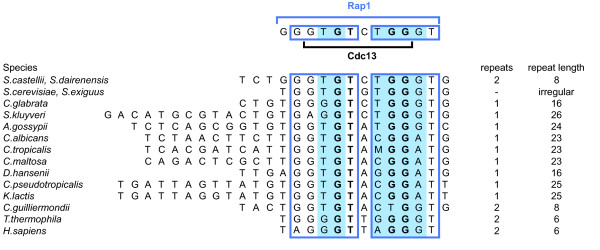Figure 4.
The Rap1 binding site is highly conserved through telomere sequence evolution and overlaps with the Cdc13 binding site sequence. Upper part, the 12-mer MBS of scasRap1 is indicated with the upper blue bar, and boxes showing the two 5 nt half-sites. Highlighted blue areas indicate the six nucleotides most important for sequence-specific binding of scasRap1. Lower black bar indicates the 8-mer MBS of scasCdc13 and bold letters indicate the four nucleotides most important for sequence-specific binding of scasCdc13. Three of these positions coincide with those most important for scasRap1 sequence specificity (bold letters in blue area). Lower part, alignment of the highly divergent telomeric sequences of different yeast species. The three nucleotides where the sequence specificity of Rap1 and Cdc13 coincide (blue+bold) are highly conserved. M indicates A or C. The genera included are Saccharomyces (S.), Candida (C.), Ashbya (A.), Debaryomyces (D.) and Kluyveromyces (K.). Homo sapiens and Tetrahymena thermophila are included since both scasRap1 and scasCdc13 bind to these sequences. Many fungi have the same telomere sequence as H. sapiens [37].

